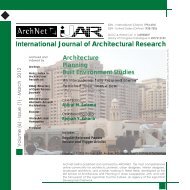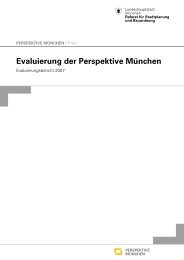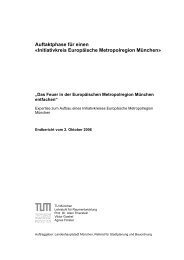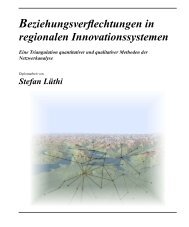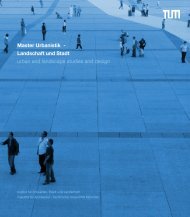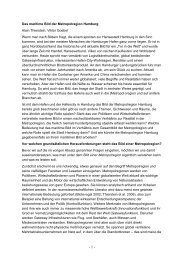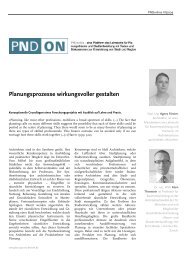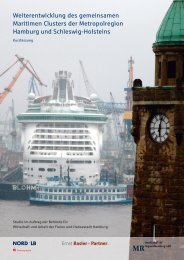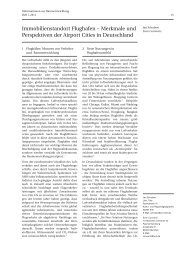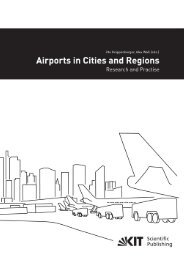Urban Development in Munich - Raumentwicklung TUM
Urban Development in Munich - Raumentwicklung TUM
Urban Development in Munich - Raumentwicklung TUM
You also want an ePaper? Increase the reach of your titles
YUMPU automatically turns print PDFs into web optimized ePapers that Google loves.
Dr A.Thierste<strong>in</strong>, S.Reiss-Schmidt: <strong>Urban</strong> <strong>Development</strong> Management <strong>in</strong> <strong>Munich</strong>, Germany<br />
44th ISOCARP Congress 2008<br />
One of the city‟s top priorities <strong>in</strong> hous<strong>in</strong>g is to annually complete 6‟000 to 7‟000 units. This<br />
objective can first be achieved by <strong>in</strong>ternal expansion as just described and second by additional<br />
options like densification of exist<strong>in</strong>g hous<strong>in</strong>g areas by fill<strong>in</strong>g gaps, add<strong>in</strong>g further floors<br />
etc. A third option is build<strong>in</strong>g up some areas at the periphery of the city-limits designated<br />
s<strong>in</strong>ce long <strong>in</strong> the land use plan for development. But s<strong>in</strong>ce a clear priority lies on the <strong>in</strong>ternal<br />
expansion, peripheral development only takes place on these designated sites, if and <strong>in</strong> so<br />
far, as the <strong>in</strong>ternal restructur<strong>in</strong>g areas are not sufficient to cover the demand for new hous<strong>in</strong>g.<br />
“Compact, urban, green” as one of <strong>Munich</strong>‟s key strategies for spatial development comb<strong>in</strong>es<br />
dense urban land use for all purposes with the promotion of mixed use developments when<br />
ever possible <strong>in</strong>stead of mono-functional commercial or hous<strong>in</strong>g areas. Together with the<br />
polycentric system of district-centres that spread over the entire city the mixed use approach<br />
will also secure a density of social life and short distances for many citizens to get to their<br />
jobs, schools and shops. This will help to <strong>in</strong>crease walk<strong>in</strong>g and cycl<strong>in</strong>g and us<strong>in</strong>g public<br />
transport <strong>in</strong>stead of private cars for the every day mobility. “Internal expansion” and “compact,<br />
urban, green” seem t<strong>in</strong>y contributions to mitigat<strong>in</strong>g climate change and the necessity to reduce<br />
CO2 production. Nevertheless they are very important elements for susta<strong>in</strong>able urban<br />
growth, not only <strong>in</strong> European cities.<br />
Figure 3 left: Spatial development guidel<strong>in</strong>e “compact, urban, green”; right: potential areas for <strong>in</strong>ternal<br />
expansion (source: City of <strong>Munich</strong>)<br />
The notion of “green” <strong>in</strong> this context implies, that parks and green open spaces <strong>in</strong> the city<br />
must not only be safeguarded and enhanced, but also significantly augmented <strong>in</strong> quantity.<br />
The rule <strong>in</strong> <strong>Munich</strong> is, that for every <strong>in</strong>habitant <strong>in</strong> new build residential areas 17 m2 of green<br />
open space <strong>in</strong> new public parks have to be provided. An important element of the strategy is<br />
the knitt<strong>in</strong>g of a network of green open spaces. It is constituted by regional green belts, big<br />
parks, green river banks, <strong>in</strong>ner-city green belts or district parks and sport facilities like the<br />
world famous Olympic Park of the1972 Olympic Games, which is still one of the most frequented<br />
parks <strong>in</strong> <strong>Munich</strong> for sports, leisure and enterta<strong>in</strong>ment.<br />
3. Three flagship projects of <strong>Munich</strong>’s <strong>in</strong>ternal expansion strategy<br />
3.1. Central railway lands<br />
The central railway lands are situated between <strong>Munich</strong>‟s ma<strong>in</strong> station and the station of Pas<strong>in</strong>g,<br />
eight kilometres west of the city centre. These not yet adequately used former railway<br />
lands are cover<strong>in</strong>g 170 hectares. In 1997, based on a master-contract between the Federal<br />
Railway Company, their land development agencies and the city of <strong>Munich</strong> a complex plann<strong>in</strong>g<br />
process started to develop five <strong>in</strong>dependent new quarters for up to 19‟000 jobs and<br />
16‟000 <strong>in</strong>habitants with an amount of nearly 70 hectares of new green open space. The Railway<br />
Company and federal government as owners agreed to realise or to pay for all necessary<br />
4



